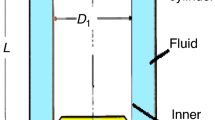Abstract
Measurements have been made by the comparison method for the effective thermal conductivity of dispersed materials which consist of substances with different thermal conductivities. The applicability of existing predicting formulae is discussed in detail as comparing their predicted values with the present data. A new predicting formula is proposed through analyzing the experimental data, the numerical results, and also the data obtained with the electrolytic-bath. It is found that the proposed formula has a wider range of applicability than that of previously reported ones.
Zusammenfassung
Die effektive Wärmeleitfähigkeit disperser Systeme, die aus Materialien mit verschiedenen Wärmeleitfähigkeiten bestehen, wurde mit einer Vergleichsmethode experimentell bestimmt. Vorhandene Formeln wurden im Detail erörtert und ihre Werte mit den Meßwerten verglichen. Eine neue Gleichung wird vorgeschlagen durch Analyse der experimentellen Daten, der numerischen Werte und auch der mit dem elektrolytischen Bad erhaltenen Ergebnisse. Diese neue Gleichung hat einen größeren Anwendungsbereich als die bisherigen.
Similar content being viewed by others
Abbreviations
- a, b, c:
-
side lengths of parallelopiped particle along main axes (a⩾ b⩾ c)
- d:
-
diameter of test specimen
- K:
-
shape factor defined by Eq. (14)
- L:
-
length defined by Eq.(13)
- n:
-
experimental constant
- t:
-
thickness of test specimen
- λ:
-
thermal conductivity
- ϕ:
-
volumetric fraction of discontinuous phase
- ψ:
-
sphericity defined by Eq. (8)
- c:
-
continuous phase
- d:
-
discontinuous phase
- e:
-
effective value
- *:
-
non-dimensional value
References
Maxwell, J.C.: A treatise on electricity and magnetism. Oxford Univ. Press. (1904) 435–441
Lord Rayleigh: On the influence of obstacles arranged in rectangular order upon the properties of a medium. Phil. Mag. 34 (1892) 481–502
Bruggeman, D.A.G.: Dielektrizitätskonstanten und Leitfähigkeiten der Mischkörper aus isotropen Substanzen. Ann. Phys. 24 (1935) 636–679
Meredith, R.E.; Tobias, C.W.: Conductivity of emulsions. J. Electrochemical Soc. 103 (1961) 286–290
Fricke, H.: A mathematical treatment of the electric conductivity and capacity of disperse systems. Phys. Rev. 24 (1924) 575–587
Johnson, F.A.: The thermal conductivity of aqueous thoria suspensions. Atomic Energy Reseach Establishment. R/R 2578 (1958) 1–18
Hamilton, R.L.; Crosser, O.K.: Thermal conductivity of heterogeneous two-component system. I. & E.C. Fund. 1 (1962) 187–191
Cheng, S.C.; Vachon, R.I.: The prediction of the thermal conductivity of two and three phase solid heterogeneous mixtures. Int. J. of Heat & Mass Transf. 12 (1969) 249–264
Tsao, G.T.: Thermal conductivity of two-phase materials. I. & E.C. 53 (1961) 395–397
Sugawara, A.; Yoshizawa, Y.: An experimental investigation on the thermal conductivity of consolidated porous materials. J. of Appl. Phys. 33 (1962) 3135–3138
Tanazawa, Y.: On the error of thermal conductivity by dimensions of apparatus, J. Japan Soc. Mech. Engrs. 35 (1932) 325–332
Kumada, T.: Thermal conductivity of suspensionsmeasurement and discussions of shaped effects of dispersions. Trans. Japan Soc. Mech. Engrs. 41 (1975) 1209–1218
Yamada, E.; Takahashi, K.: Effective thermal conductivity of suspensions — First report. Heat Transf. Japanese Res. 4 (1975) 83–101
Heywood, H.: Numerical definitions of particle size and shape. Chemistry & Industry. 56 (1937) 149–154
Author information
Authors and Affiliations
Rights and permissions
About this article
Cite this article
Yamada, E., Ota, T. Effective thermal conductivity of dispersed materials. Wärme- und Stoffübertragung 13, 27–37 (1980). https://doi.org/10.1007/BF00997630
Received:
Issue Date:
DOI: https://doi.org/10.1007/BF00997630




